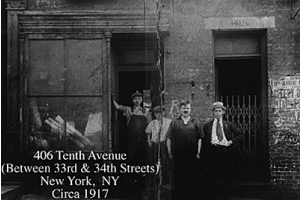Historical Metalwork Documents Find a Permanent Home

By Lorin Wertheimer a freelance writer in Brooklyn, NY
Jay Shah had a problem. He’d been entrusted with the files of P.A. Fiebiger, one of the Twentieth Century’s premiere ornamental metalwork fabrication companies. He knew the collection of architectural drawings, project photos, receipts and miscellaneous papers spanning generations was historically significant, but he didn’t know what to do with it.
The documents had come to Shah in 2021, after a call from his long-time friend and former client Joe Fiebiger. Fiebiger, grandson of founder and master blacksmith Paul August Fiebiger, ran the family business from 1965 until it closed in 1994. It was work the third-generation craftsman Fiebiger loved, a love reflected in the title of his book, “Pretty Things for Nice People.”
For most of the Twentieth Century, the papers had been stashed up on the fourth floor of the Fiebiger workshop in Manhattan’s Hell’s Kitchen, on the Southeast corner of 36th Street and Tenth Avenue, not far from the entrance to the Lincoln Tunnel.


Joe Fiebiger
Documents under 48 inches had been kept in large architectural filing cabinets, while larger drawings were rolled up and stored in a barrel. “There’s hundreds of sketches,” Joe Fiebiger said on a phone interview from his home in New Mexico. “On gates, fences, even things you never heard of like well heads, and bell entry systems like in Downton Abbey… and they were all designed in the drafting area of the office.”
By the time Fiebiger contacted Shah, the collection had already been on quite a journey. Fiebiger had taken it with him when he retired out West, but he’d known that wasn’t where it was meant to end up. “He didn’t want it in New Mexico,” said Fiebiger’s friend, David Cann, when interviewed on the phone. “So I said send it out here to New Jersey, just get it out here. I had room to store it.”


The shop at 462 Tenth Avenue, NYC (36th Street) with employees and Joe’s father, Paul James Fiebiger. The windows were never that clean again.
So the papers were shipped to Cann around 2016, still in the crates they’d been packed into when P.A. Fiebiger closed its doors. The crates sat on big shelving units in Cann’s shop, a design company that specializes in fine art conservation, on the New Jersey side of the Pennsylvania/Jersey border.
But the materials were a bit of a white elephant. They occupied a lot of space, weren’t well preserved, and neither Cann nor Fiebiger had any practical use for them. They were too valuable to get rid of and too cumbersome to keep.
But more than that, “Joe wanted to put the stuff out there for people’s use. He didn’t want it to go and just die. He said, ‘If I wanted it to go die I would have just burned it,’” Cann recalled. And he could relate. “A lot of people go into crafts making things because they want something of themselves to live on longer than their own lifetime.”
By 2021, it had been almost thirty years since Fiebiger had retired. Cann could tell “Joe was getting frustrated. He said, ‘What do I do with this stuff?’ I said I didn’t know.”
“We were trying to find a home for them,” Fiebiger recalled. That’s when he turned to Shah. Even though they had never met in person, they’d talked several times a year since the 1990s. And they respected each other. “Jay’s an amazing guy,” Fiebiger said. “He loves the art… and he didn’t want to see it get lost.”
Fiebiger had met Shah through the company Shah worked for and later ran, Architectural Iron Designs, Inc., or AIDI, an ornamental metal components supplier. Fiebiger knew Shah not only had a love for ornamental metalwork – it was his business, after all – but for architectural history. He hoped Jay might be able to get some use out of the sketches. “I mentioned it to Jay just in talking casually, cause we would talk sometimes and he liked to talk about the art… I said to Jay, there were designs in there that you might want to study and make prototypes of and put into your collection and sell. There are some things that are kind of cool and people might like them.”


Hirsch at Bow Bridge in Central Park
restored by P.A. Fiebiger.
Shah was surprised and flattered when Fiebiger offered him his collection. “He wanted me to just have it and do whatever I want with it,” he said when interviewed in his New Jersey office. More than amazed, he was intrigued. He drove the hour to David Cann’s workshop and found “a treasure trove of historical works.” The drawings included ornamental metalwork done for the United States Supreme Court building and the Capitol, wrought iron fencing, gates, and stair railings for places like the Metropolitan Museum of Art, work done for the Rockefellers and the Astors, the restoration of landmarks like Central Park’s Bow Bridge, and most notably, the complete restoration of the Statue of Liberty from 1983-1986.
Equally jaw-dropping was the quality of the drawings. Shah knew the work was “done by a group of artists spanning three generations... There are not many people that actually do this caliber of work.” To Shah, it was a no-brainer. He told his friend he’d be happy to take custody.
Shah loaded the eleven bankers boxes filled with files and the long tubes containing the rolled up drawings onto a flatbed truck and brought them back to the AIDI offices in Plainfield, New Jersey. A few months later, when Shah and AIDI moved to new offices in Bridgewater, NJ, the files came with him.
One advantage of AIDI’s new space was that it had a storage room, so Shah no longer had to share an office with the sizeable collection. But that didn’t mean it was any less on his mind. He really wanted to find a permanent home for it and he wanted to do it ASAP.
“What immediately came to mind was to try and raise funds for the NOMMA (National Ornamental & Miscellaneous Metals Association) Education Foundation (NEF),” Shah said. Shah served on NEF’s board of trustees and knew the organization’s annual auction was coming up.


The men and Joe at the face of Lady Liberty.


Ellis Island Spires with one of Joe’s Bruno Ranieri standing proudly in them.
Even though the collection was a bonanza of historical documents, it was going to be tough to find a buyer. Ornamental metalwork is already a niche industry; as Shah wrote in an email, “Ironwork is pretty esoteric for the average consumer and unfortunately most people just walk by fantastic metalwork without even noticing it.”
Finding someone interested in the hundreds of drawings who also had the space to keep them was a big ask. After some investigation, Shah realized he would only get a couple hundred dollars for the files, far below what he considered their true value. He would surely raise more if he sold off the papers one by one, but Shah wasn’t willing to do that. “I didn’t want to break up the collection into individual pieces,” he said. “Because then you lose the whole story.”
Once the difficulties of selling the collection became clear to Shah, he started thinking about donating them to a museum. He knew Fiebiger had already tried to give the collection to the Mechanics Institute and the Avery Library – the latter seemed like a great fit because the papers contained drawings from many renowned architects already in the their collection – but neither had worked out.
Enter Karine Maynard. A fellow NEF Board of Trustees member and vice president of Maynard Studios (itself dedicated to ornamental metal fabrication), Maynard knew locating a museum able to take the materials would be a heavy lift. She told Jay and the NEF board that most museums “wouldn’t have a budget to house that type of collection,” she said over the phone, taking a break from installing her own ironwork to recount her part in finding a home for the Fiebiger collection.
The sheer scope of it, the importance of it, meant they’d be better off targeting bigger museums. In order to do that, they’d have to document exactly what was in the collection. That meant going through the documents with a fine tooth comb and taking pictures of, if not everything, than at least the blueprints.
“It was a complete failure as a fundraiser,” Maynard admitted; if Shah wanted to save the collection, he was going to have to spend money.
Shah put his summer intern, Hirsch Chheda, who happened to be his nephew, to work cataloging the papers. Hirsch had just finished his first year at University of California, Riverside. He’d end up spending his entire internship going through the Fiebiger materials. It wasn’t how he’d expected to spend his summer, but he was game to take on the assignment. “I have a little bit of OCD, so I really liked it,” Chheda said in an interview.


From a book of German designs. Joe’s grandfather Paul August Fiebiger, whom he always called Opa made it with the help of many in the early part of the 20th Century. The man fighting is done as a repousse piece in iron with welded seams.
Like his uncle, Chheda was amazed by the quality of the blueprints. “They’re all hand drawn,” he recounted, the awe in his voice apparent. “The oldest pieces, they’re way older than me, that’s for sure.” Chheda was surprised to find material dating back to the 1920s and 30s. “It was crazy.”
Cataloging the papers was challenging. A lot of blueprints were missing legends, so much of Chheda’s job was detective work, finding which papers belonged together. “It was quite a task,” he reminisced, like putting together a thousand piece jigsaw puzzle without a picture for guidance.
While Chheda documented the documents, Maynard reached out to museum contacts. An artistic trail of breadcrumbs lead to the Smithsonian’s head curator Rand Griffey, who suggested they try the National Building Museum. “That wasn’t even on our radar,” Maynard said. “I didn’t know that there was a National Building Museum.”


Jay & Bryn at the National Building Museum during the delivery of the collection at the museum.
NEF’s proposal went to the NBM’s internal review committee. Especially helpful was the spreadsheet Chheda had spent weeks compiling at Shah’s behest. Cooley recalled, “Jay had very lovingly cataloged the whole thing and digitized a lot of it and sort of categorized it which made it very easy for us to review.”
NBM’s committee was impressed. Cooley said, “the fact that this is a family-run business over several generations that deals with a breadth of types of work, from personal and residential all the way up to national in scale, is one of the things that was most interesting to us about the collection.” In June 2024, thirty years after P.A. Fiebiger closed its doors, the museum accepted the papers into its permanent collection.
Shah felt a little bittersweet about the drawings leaving his possession, but the overwhelming feeling was satisfaction. He wrote that he was proud of the small role he played “in preserving a bit of history, especially since it is from the industry that I work in. It also makes me happy to see the legacy of Joe Fiebiger and his firm continue in a small way.”
He planned to personally transport the Fiebiger collection to Washington, D.C. a few weeks after he was interviewed. “I’ve never actually been to the museum myself,” he said. “It’s a huge building. I’m excited to see what they do with it.”
As to how the materials will fit into the NBM collection, Cooley won’t venture to predict, but it’s likely won’t all be found in the gallery. “There’s probably less than 1% of our collection on display at any given moment,” she said. One of the ways they’ll be used is to help preserve P.A. Fiebiger’s work across the country. “We get requests from historic restoration companies or preservation companies that are restoring places. They need the drawings to be able to understand the story, how something was put together.” Just as Joe Fiebiger and Jay Shah had hoped.
At the end of Chedda’s internship, Shah drove his nephew to New York City so they could see P.A. Fiebiger’s ironwork in situ. “We started at the Carl Schurz Park on the upper east side of Manhattan and we struck gold,” Shah wrote. They found the sign for the Polly Gordon Walk and the park’s accompanying ironwork.
After that it was a scavenger hunt southward, crisscrossing the island of Manhattan from east to west. “The work ranged from light fixtures to railings to doors.” Sometimes they’d be able to match what they saw with a drawing Chedda had catalogued. Sometimes there was no metalwork to be seen.
Near the end of the tour they came to the Morgan Library. The neoclassical building features an abundance of intricate, striking ironwork that P.A. Fiebiger restored in the mid-1970s. The two men admired the fine craftsmanship, still beautiful a hundred years after it had been created and fifty years after Joe Fiebiger’s restoration. They stood there in awe as countless pedestrians walked past without giving them, or the metalwork they loved, so much as a glance.
To view the complete works of PA Fiebiger, visit
http://www.pafiebiger.com/


Sign at Polly Gordon Walk, Carl Schurz Park, uptown Manhattan.
“A lot of people don’t know that we exist,” Collection Manager Bryn Cooley explained from her Washington, D.C. office over the phone. “And they don’t know we’re not part of the Smithsonian… The museum was created by an act of Congress in the late 1970s. The charge given was to create a museum to the building arts.”
The Building Museum building is itself impressive. It was built in 1887 to house the United States Pension Bureau, which at the time was consumed with handing out pensions to Civil War veterans. A frieze depicting Civil War soldiers wraps around the building and encases an interior so vast it has been used to host more than one presidential inaugural ball. The museum boasts soaring interior columns and a collection of over half a million pieces.


Exterior of the National Building Museum in Washington DC.


Main Entrance Gates for Dr. Cole’s estate in Tarrytown, NY. They are a metaphor for Washington Irving’s characters. The characters are hammered into the lock box. Executed in Forging Bronze. Ca. 1923. Note the light fixtures in the stone piers.


Louis XVI stair railing designed by architect Alexander MacIlvane. This was in the estate of Marjorie Meriweather Post in Washington. Now Hillwood Museum.


Metalwork at Frick Museum in NYC, restored by P.A. Fiebiger.


Metalwork at Morgan Library, NYC, restored by P.A. Fiebiger.














